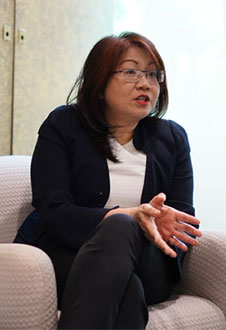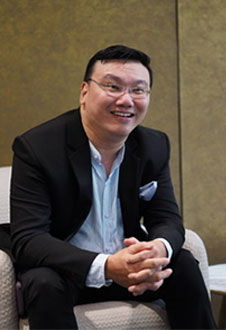Patients and their family members can be a powerful source of medical philanthropy. This is because they are often deeply touched by their care provider, the care and concern they received or their own life-altering experiences.
Giving is a part of the healing process; and a patient an ally in their quest to help other patients heal.
In the second of this three-part series (click here for part one), we hear from two veterans who work behind the scenes to make philanthropic support happen for SingHealth. They share how giving provides the opportunity for patients to be a part of something bigger than they can accomplish alone.
Clara & Ian
Clara Lim, Director, Development Office, Singapore General Hospital (SGH), moved from a career in marketing to do development work 15 years ago. She now heads the Development Office at SGH.
Leo Chen Ian, Director, Development and Community Engagement, Singapore National Eye Centre (SNEC) leads the development team at SNEC. He previously worked in a non-profit organisation.
1. How long have you been in development? What made you choose a career in this line?
Clara: I used to do regional marketing for a consumer electronics company.There was a job opening for a major gift officer and the idea of working and doing good at the same time was very appealing to me. After so many years, I still feel very blessed that the work I do can benefit someone. Being able to do good every day is priceless.
Ian: I trained as a molecular biologist, and worked in a university doing research after graduation. I then moved to a non-profit organisation to facilitate and run programmes before hopping to the other side of the fence to philanthropy. My new role to represent the philanthropic interest of our donors allowed me to travel frequently for work.
When I became a father, I wanted to be more homebound, which led me to SNEC in July 2017. I have never looked back since.
2. What has your journey as a development officer been like?
Clara: Coming into a public healthcare setting, I’m humbled by the people that I meet and the work that they do – clinicians, nurses and various stakeholders.
Their desire to stay in public healthcare underscores their commitment to providing healthcare for all and improving the patients’ lives. Through research, education and patient care programmes, philanthropy allows us to do more for our patients and nurture the next generation of healthcare teams, and find cures. It’s been an absolute privilege to be on this journey with my SGH colleagues.
Ian: Development work at SNEC was still fairly new when I joined. So I was tasked to set up the development office and build a culture of giving here. It is definitely a boost when senior management is supportive and believe that philanthropy is a key pillar of the organisation.
3. Can you share some memorable moments or anecdotes? Can you share with us about one grateful patient donor that stood out for you?
Clara: One of our regular donors is an elderly gentleman. He doesn’t know how to make an online donation or use Paynow. However, he is grateful for what he has and wants to help patients who are in need and cannot afford to pay for medical care even after prevailing subsidies. He used to call us regularly to make his gift, and has been doing so for the past few years. Now he can visit the SGH Office of Patient Experience at Block 6 to make a donation towards SGH Needy Patients Fund.
We have another donor who donates $1 every day towards SGH Needy Patients Fund since November 2019 via Paynow. Since 2021, he has increased his donation to $2 per day. Till today, his daily donations continue, including Saturdays and Sundays. I am very inspired by our donors. There’s really no gift that’s too small to bring hope to someone.
Ian: Being in a public healthcare institution gives us the opportunity to encounter many of these grateful patients who give so willingly. There was one day where an ex-patient of SNEC called us and expressed her desire to make a donation. When I met her, she arrived with her sister, and made a gift of about a few thousand dollars.
After which, she took out a piece of paper from her bag with a list of names written on it. It had the names of her family members and friends whom she had approached to contribute to the gift. Her sincerity and generosity really moved me.
4. How does grateful patient giving differ from other forms of giving? Does it become more powerful due to the personal connection?
 Ian: When a grateful patient makes a gift, it is not only because of the work of the development officer. We are just a conduit for donors and help to facilitate the gift. Every staff that patients meet along their journey to recovery has an important role to play. It is because of their good work – from the clinicians and nurses to Patient Service Associates – that inspires patients to give.
Ian: When a grateful patient makes a gift, it is not only because of the work of the development officer. We are just a conduit for donors and help to facilitate the gift. Every staff that patients meet along their journey to recovery has an important role to play. It is because of their good work – from the clinicians and nurses to Patient Service Associates – that inspires patients to give.
A donation from a patient has a personal significance; usually they are going or have gone through a long and arduous journey with their health, and they want to do something tangible to close this chapter. When they bring you alongside this journey that is so personal to them, it is rewarding.
There was one patient who had an eye ailment. She had tried and exhausted every available option she could find, until her clinician discovered that her eye problem was genetic. She then urged her family members to undergo genetic testing so that they can better prepare themselves. This led to a gift from the patient and enabled our clinician to successfully set up a genetic bank for this condition for research.
Clara: There is a saying: ‘a grateful heart is a magnet for miracles’. I’m a grateful witness of many miracles in SGH. We have a patient who suffered from a rheumatological condition. With this being a chronic condition with no cure, she decided to step up and work with our clinicians to raise funds and awareness for rheumatological diseases. With the support from friends, well-wishers and other patients, the Reverie Rheumatology Research Fund was set up and is now working towards an endowment fund together with the dollar-for-dollar government matching, that will nurture many young clinician scientists and support at least 5 research projects every year. You can find out more about their fundraising efforts here.
5. What advice can you give someone considering or starting out a career in development?
Ian: Apart from enjoying meeting and interacting with people, I feel that one key trait that someone must have is the ability to listen, and not just hear. You learn a lot from someone just by listening to what they have to say, and the stories they tell.
Another key trait is patience. Singaporeans are generally quite generous, but the culture of philanthropy is still relatively new. There is a ‘substantial gestation’ period for the work before someone would make a gift and you may not be around when it happens. At the end of the day, I know that my work here, in one way or another, is helping someone’s life, and it is one of the best places to be in.
Clara: Totally agree! If you are someone who is passionate and determined to act on your compassion, a job in development may be one area to consider. The learning curve may be steep but there’ll never be a boring day or a project that does not help someone.
6. What do you do in your free time to unwind?
Ian: I’m a father of two teenage boys, and I’m also an animal lover. With the kids all grown up, we now raise rescued animals. We currently have a rescue dog and cat, and recently welcomed a rescued kitten.
Clara: I’ve been a vegan for almost a decade. Compared to 10 years ago, now there are a lot more vegan eateries and inclusive dining places with interesting vegan options. I enjoy trying different vegan eats like Korean and Japanese, and recreating these vegan dishes at home. One of my current favourite is vegan unagi don using eggplants.
